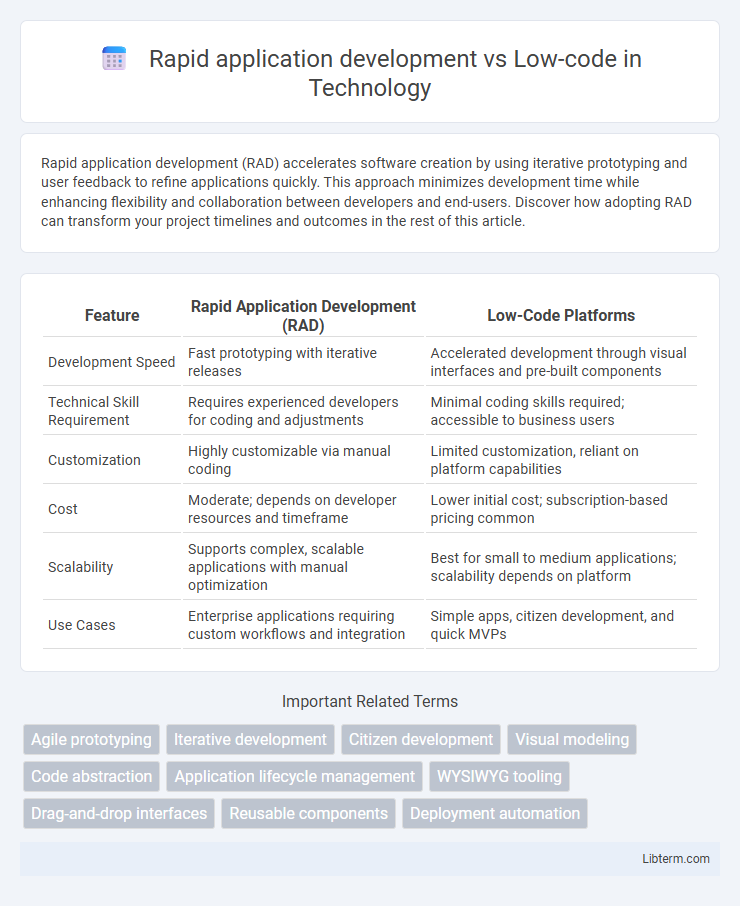Rapid application development (RAD) accelerates software creation by using iterative prototyping and user feedback to refine applications quickly. This approach minimizes development time while enhancing flexibility and collaboration between developers and end-users. Discover how adopting RAD can transform your project timelines and outcomes in the rest of this article.
Table of Comparison
| Feature | Rapid Application Development (RAD) | Low-Code Platforms |
|---|---|---|
| Development Speed | Fast prototyping with iterative releases | Accelerated development through visual interfaces and pre-built components |
| Technical Skill Requirement | Requires experienced developers for coding and adjustments | Minimal coding skills required; accessible to business users |
| Customization | Highly customizable via manual coding | Limited customization, reliant on platform capabilities |
| Cost | Moderate; depends on developer resources and timeframe | Lower initial cost; subscription-based pricing common |
| Scalability | Supports complex, scalable applications with manual optimization | Best for small to medium applications; scalability depends on platform |
| Use Cases | Enterprise applications requiring custom workflows and integration | Simple apps, citizen development, and quick MVPs |
Introduction to Rapid Application Development and Low-Code
Rapid Application Development (RAD) emphasizes iterative prototyping and user feedback to accelerate software development cycles, reducing time from concept to deployment. Low-code platforms enable developers to build applications through visual interfaces and pre-built components, minimizing hand-coding and enhancing accessibility for non-developers. Both approaches prioritize speed and agility but differ in methodology, with RAD focusing on process and collaboration, while low-code centers on platform-driven development.
Core Principles of Rapid Application Development
Rapid Application Development (RAD) centers on iterative prototyping, user feedback, and flexible design to accelerate software delivery, contrasting with low-code platforms that focus on visual development and drag-and-drop interfaces to simplify coding. Core principles of RAD include time-boxed phases, active user involvement, and modular construction to enhance collaboration and reduce development cycles. While low-code emphasizes reducing the need for traditional coding skills, RAD prioritizes adaptive planning and quick iterations to meet evolving user requirements efficiently.
Fundamental Features of Low-Code Platforms
Low-code platforms feature visual development tools, reusable components, and built-in automation that accelerate application creation without deep coding expertise. They emphasize drag-and-drop interfaces, integration capabilities with various APIs, and governance controls to ensure scalable and secure software deployment. Rapid application development often relies on iterative prototyping, whereas low-code platforms streamline this process through simplified, model-driven designs that enhance collaboration between business and IT teams.
Key Differences Between RAD and Low-Code
Rapid Application Development (RAD) emphasizes iterative prototyping and user feedback with minimal planning, focusing on speed for custom software solutions. Low-code platforms provide visual development tools and pre-built components, enabling faster app creation with minimal hand-coding and often targeting less technical users. Key differences include RAD's reliance on skilled developers for customization versus low-code's drag-and-drop simplicity, as well as RAD's flexible, project-specific approach compared to low-code's platform-driven standardization.
Benefits of Rapid Application Development
Rapid Application Development (RAD) enables faster project completion by emphasizing iterative development and prototyping, reducing time-to-market significantly compared to traditional methodologies. It promotes enhanced user involvement through continuous feedback, ensuring the final product closely aligns with user requirements and improves overall satisfaction. RAD's flexibility allows quick adaptation to changing business needs, reducing development risks and costs while accelerating innovation.
Advantages of Low-Code Development
Low-code development accelerates application delivery by enabling developers to build software with minimal hand-coding through visual interfaces and pre-built components, significantly reducing time-to-market. It enhances collaboration between business users and IT teams by providing an accessible platform that simplifies complex coding tasks, leading to greater agility and adaptability in project execution. Low-code platforms also improve scalability and maintenance with plug-and-play features, making it easier to update applications in response to evolving business requirements.
Use Cases: When to Choose RAD Over Low-Code
Rapid Application Development (RAD) is ideal for projects requiring highly customized solutions with complex integrations and when the development team has strong coding expertise. Low-code platforms suit business users or IT teams aiming to quickly build standard applications with minimal coding and faster deployment. Choose RAD over low-code when the project demands fine-grained control, scalability, and extensive customization beyond the limits of low-code environments.
Challenges and Limitations of Each Approach
Rapid application development (RAD) faces challenges such as limited scalability and potential for technical debt due to its focus on speed and iterative prototyping. Low-code platforms often confront restrictions in customization and integration complexity, which can hinder handling enterprise-grade applications with unique requirements. Both approaches may struggle with governance, security concerns, and dependency on platform vendors, impacting long-term maintainability and flexibility.
Future Trends in Application Development
Rapid application development (RAD) emphasizes iterative prototyping and user feedback for faster software delivery, while low-code platforms enable simplified drag-and-drop interfaces reducing the need for extensive manual coding. Future trends highlight the integration of AI-driven automation and more robust collaboration tools within both RAD and low-code environments, accelerating innovation and improving developer productivity. Increased adoption of cloud-native architectures and API-first designs further enhances scalability and seamless integration across diverse enterprise systems.
Conclusion: Selecting the Right Approach for Your Business
Choosing between Rapid Application Development (RAD) and Low-code platforms depends on the specific needs and resources of your business. RAD offers flexibility and faster iteration for complex projects with experienced developers, while Low-code provides ease of use and quicker deployment suited for non-technical users and standard app requirements. Evaluating project complexity, development speed, and team expertise ensures the right approach aligns with your business goals and maximizes return on investment.
Rapid application development Infographic

 libterm.com
libterm.com